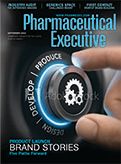The Murky Outlook for Generic Drugs
Pharmaceutical Executive
Market consolidation limits sales, while legal challenges offset regulatory gains.
The recent merger proposal involving Pfizer and Mylan reflects continued turmoil in the generic drug industry, as market pressures drive down prices, while “price gouging” charges draw public hostility and erode industry’s credibility. Leading US generics makers face stiffer competition from Indian and other
Jill Wechsler

foreign firms, eroding revenues needed to shore up outdated manufacturing facilities. The resulting shortages, particularly for quality sterile injectables, draw sharp criticism from lawmakers and healthcare providers about putting patients at risk.
A main problem for generics firms is that continued consolidation among wholesalers and pharmacies has curbed their ability to negotiate profitable rates. And with fewer blockbuster drugs coming off patent, manufacturers have limited opportunities to boost sales with low-cost versions of widely used medicines. Brands, moreover, look to delay competition through complex patent strategies, curbs on access to supplies for bioequivalence testing, and more “authorized” generics.
The merger of Pfizer’s Upjohn division with Mylan to form a stronger company offers one Âstrategy for generics firms to gain more leverage with suppliers and customers.1 Only a few years ago, Mylan was looking to take over several competitors, but Âmanufacturing problems and pricing missteps reduced its market value, as is the case with other leading generics firms. Last year, Novartis sold portions of its Sandoz generics arm and indicated that its remaining Sandoz operation would focus more on biosimilars and complex generics. Teva has scaled back operations to cut costs, while also acquiring smaller competitors. It remains to be seen if the new Upjohn-Mylan firm will contend more effectively with stiff competition at home and in volatile foreign markets without its Pfizer link.
Under investigation
Meanwhile, price-fixing charges have hit the generic drug industry hard. In addition to federal actions, more than 40 states have sued 20 generics firms for alleged collusion.2 State and federal enforcers continue to challenge pay-for-delay deals with brands as designed to postpone generic competition. In July, generics makers Teva, Endo Pharmaceutical, and Teikoku of Japan agreed to pay nearly $70 million to California to resolve anti-competition charges.
At the same time it announced its merger with Pfizer, Mylan disclosed a $30 million settlement with the Securities and Exchange Commission (SEC) to close an investigation related to EpiPen price hikes. This follows a 2017 settlement with the US ÂDepartment of Justice (DOJ) over failure to pay appropriate Medicaid rebates on EpiPen sales, just one of a range of legal actions related to controversial price hikes for its anaphylaxis treatment.
Ironically, analysts continue to document how wider prescribing of generics can cut costs for healthcare programs. A recent article in JAMA Internal Medicine found that greater switching to generic versions of widely prescribed drugs for hypertension and heart failure would have saved Medicare almost 90% of the $754 million spent on angiotensin converting enzyme inhibitors (ACEIs) and angiotensin-II-receptor blockers (ARBs) in 2016 and 2017.3
Regulatory support
A way for FDA to bolster competition that can help reduce US drug prices involves streamlining and accelerating its process for evaluating and approving abbreviated new drug applications (ANDAs). The Office of Generic Drugs (OGD) in the Center for Drug Evaluation and Research (CDER) has utilized revenues from generic drug user fees to expand operations and clarify policies, leading to a record-breaking 1,000 ANDA approvals last year, including a number of first generics. CDER is issuing more guidances and updating its Orange Book to support generic drug marketing.
A related OGD initiative is to compel manufacturers to file more complete ANDAs that can be processed and approved in one review cycle, avoiding time-consuming discussions on application short-comings. A recent report from the Government Accountability Office (GAO) advises FDA to do more to ensure that

initial ANDAs are complete and more efficiently assessed.4 The analysts found that only 12% of more than 2,000 ANDAs reviewed by FDA between 2015 and 2017 were approved in the first cycle, with delays largely linked to product quality and plant inspection issues.
FDA also supports the development and approval of more complex generics, such as topicals and inhaled products, to provide alternatives to pricey innovators. As part of an FDA Drug Competition Plan, the agency has published lists of more than 500 drugs that lack competition and are eligible for extra FDA assistance in determining what tests and data are needed to gain market approval.5
Despite the surge in ANDA approvals, generics makers still struggle to gain market share due to a steady rise in brand companies developing and marketing “authorized” generics of their own medicines facing a loss in patent protection and new competition. By launching before patent expiration, the innovator firm can maintain sales and profits because these products don’t carry rebates. Analysts count some 1,200 authorized generics in the US that can raise costs over the long run by discouraging competition from outside manufacturers.
Members of Congress have proposed numerous measures designed to enhance competition in the drug market. Generics firms have pressed hard for legislation that prevents brands from blocking access to samples of reference products for required testing, along with measures to improve patent listings in FDA’s Orange Book and Purple Book for biosimilars. But generics makers oppose bills that set time limits for first generics to implement 180-day exclusivities.
Jill Wechsler is Pharmaceutical Executive’s Washington Correspondent. She can be reached at jillwechsler7@gmail.com
References
1. https://www.pfizer.com/news/hot-topics/a_new_champion_for_global_health
2. https://www.rand.org/blog/2019/07/price-fixing-case-reveals-vulnerability-of-generic.html
3. https://jamanetwork.com/journals/jamainternalmedicine/article-abstract/2740205
5. https://www.fda.gov/drugs/2018-office-generic-drugs-annual-report

Navigating Distrust: Pharma in the Age of Social Media
February 18th 2025Ian Baer, Founder and CEO of Sooth, discusses how the growing distrust in social media will impact industry marketing strategies and the relationships between pharmaceutical companies and the patients they aim to serve. He also explains dark social, how to combat misinformation, closing the trust gap, and more.
Pfizer, GSK Gain ACIP Recommendations for RSV and Meningococcal Vaccines
April 18th 2025The Centers for Disease Control and Prevention’s Advisory Committee on Immunization Practices voted to expand access to Pfizer’s respiratory syncytial virus vaccine Abrysvo for high-risk adults in their 50s and voted in favor of GSK’s meningococcal vaccine, Penmenvy, for streamlined adolescent protection.